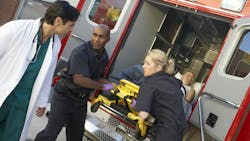Study: Impact of Lung Ultrasounds in the Prehospital Setting
A study entitled “Prehospital lung ultrasound in acute heart failure: Impact on diagnosis and treatment” was published last year in Academic Emergency Medicine.
According to that study, patients with acute heart failure (AHF) are commonly misdiagnosed and undertreated in the prehospital setting. The study said, “These delays in diagnosis and treatment have a direct negative impact on patient outcomes. The goal of this study was to determine the diagnostic accuracy of paramedics with and without the use of lung ultrasound (LUS) for the diagnosis of AHF in patients with dyspnea in the prehospital setting. Secondarily, we assessed LUS impact on rate of and time to initiation of HF therapies.”
Further, “This was a prospective interventional study on a consecutive sample of patients transported to the hospital by one emergency medical services agency. Adult patients (>18 years) with a chief complaint of dyspnea were included. LUS was performed by trained paramedics and was defined as positive for AHF if both anterior–superior lung zones had greater than or equal to three B-lines or bilateral B-lines were visualized on a four-view protocol. Paramedic diagnosis was compared to hospital discharge diagnosis which served as the criterion standard.”
As for the results, the study noted, “Of the 264 included patients, 94 (35%) had a final diagnosis of AHF. Forty total patients had a LUS performed; 17 of these patients had a final diagnosis of AHF. Sensitivity and specificity for AHF by paramedics were 23% (95% confidence interval [CI] 0.14–0.34) and 97% (95% CI 0.92–0.99) without LUS and 71% (95% CI 0.44–0.88) and 96% (95% CI 0.76–0.99) with the use of LUS. In the 94 patients with AHF, 14% (11/77) received HF therapy prehospital without the use of LUS and 53% (9/17) with the use of LUS. LUS improved frequency of treatment by 39%. Median time to treatment was 21 min with LUS and 169 min without.”
Healthcare Purchasing News had the opportunity to speak to one of the study’s authors, Frances Russell, M.D. Russell is a tenured professor of emergency medicine and the ultrasound research director in the division of ultrasound at the Indiana University School of Medicine. She earned her Doctor of Medicine at the University of Wisconsin, Madison School of Medicine and Public Health. She has over 50 peer-reviewed publications, has received grant funding from the NIH NHLBI and American Heart Association, in 2021 received the Society of Academic Emergency Medicine (SAEM) Academy of Ultrasound (AEUS) Academic Excellence award, and in 2023 received the SAEM AEUS Most Influential Researcher award. Dr. Russell currently serves as an American College of Emergency Physician (ACEP) ultrasound research subcommittee co-leader and previously served on the SAEM AEUS executive committee as the Research Officer.
How prevalent is acute heart failure (AHF)? Is this a major problem in the U.S.?
More than a million patients are hospitalized with AHF annually. AHF refers to the rapid onset or worsening of signs of heart failure with symptoms that include severe shortness of breath, swelling in the legs and abdomen, and fatigue. AHF has a high healthcare cost burden accounting for over 20 billion dollars annually.
A leading cause of unplanned hospitalizations in the U.S., AHF is triggered by various factors, including medication non-compliance, diet non-compliance, heart attacks, and high blood pressure. As symptoms are similar to other conditions, such as chronic obstructive pulmonary disease (COPD), pneumonia, or asthma, AHF is challenging for first responders to diagnose correctly. Delayed diagnoses and treatments lead to poor outcomes for many patients - more than a quarter of patients diagnosed with AHF will die within 12 months.
How can ultrasound imaging help with AHF?
Lung ultrasound (LUS) can significantly help diagnose AHF and allows for quicker identification of AHF cases, compared to waiting for other diagnostic test results such as chest X-rays. It has also been shown to be more accurate than traditional diagnostic methods such as patient history, physical examination, and blood tests.
How common is it for paramedics to receive ultrasound training?
Ultrasound is not yet a standard skill for most paramedics in the U.S, although it has been adapted in prehospital settings for decades in other countries. In the U.S., field use of ultrasound is in a developmental stage, with ongoing research and implementation efforts. Within the last decade, the onset of more affordable, portable, all-in-one ultrasound probes – like the ones we used in our study—have made paramedic adoption increasingly feasible, supporting this transition toward a new standard of care.
What about staff in other prehospital settings?
In Europe, prehospital physicians are commonly using prehospital ultrasound to help guide care in patients with shortness of breath. Other studies have shown that, with modest investments in training and equipment, ultrasound could prove helpful for flight nurses or critical care paramedics, trauma assessments, and mass casualty incidents. Really, handheld ultrasound could be used in nearly any situation where healthcare providers and other medical staff need to quickly get an idea of what’s happening within the body.
Are there any challenges associated with paramedics having ultrasound technology on their ambulance? What is the financial burden?
One challenge we encountered during our study was that about 20% of patients whose symptoms qualified them for the study did not receive LUS when one was available on the ambulance. We theorize that some paramedics might have been less confident in their skill with use of the handheld ultrasound device or did not save images or interpretations.
Ongoing training would likely be the largest investment an emergency services provider would need to make, as the cost of the devices themselves is relatively affordable as medical equipment goes – just a couple thousand dollars.
Can you talk about the results with us? Was any of this surprising?
Our study looked at training a group of 26 full-time paramedics to diagnose AHF using a handheld portable ultrasound device from Butterfly Network. The training consisted of 30 minutes of classroom education, followed by 30 minutes of hands-on scanning. Participants also had to pass a written test and demonstrate competent use of the Butterfly device.
We found that paramedics with little to no prior training in LUS were able to use this tool accurately in the pre-hospital setting and that advanced diagnostic tools increased correct diagnoses of AHF by paramedics from 23% to 71%, with a very small 2.5% rate of false positives.
The significantly higher level of accuracy achieved by paramedics with relatively minimal training was impressive. This was not unexpected as we know LUS is easy to learn and can be performed by non-physicians. From a patient care perspective, there was a significant reduction in average time to treatment – from almost three hours to just 21 minutes when paramedics used the LUS device. Since we know that earlier treatment of AHF is associated with better outcomes, this could have a significant positive impact on mortality.
Will there be further studies done with additional EMS teams?
We purposefully limited the size of this pilot study to determine if handheld ultrasound devices could be adapted into prehospital management of patients experiencing AHF. More research is needed with a larger cohort of patients and with other EMS agencies. We also have plans to evaluate paramedic performed LUS with an AI augmented interpretation to evaluate diagnostic accuracy.


